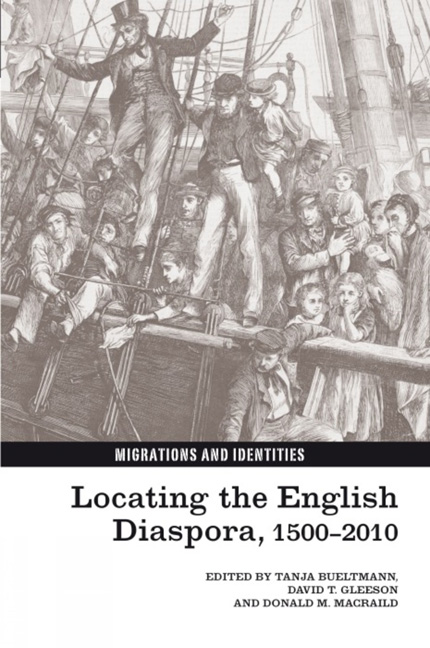Book contents
- Frontmatter
- Contents
- Notes on Contributors
- Introduction. Locating the English Diaspora: Problems, Perspectives and Approaches
- 1 Mythologies of Empire and the Earliest English Diasporas
- 2 The English Seventeenth Century in Colonial America: The Cultural Diaspora of English Republican Ideas
- 3 Fox Hunting and Anglicization in Eighteenth-Century Philadelphia
- 4 The Hidden English Diaspora in Nineteenth-Century America
- 5 An English Institution? The Colonial Church of England in the First Half of the Nineteenth Century
- 6 The Importance of Being English: English Ethnic Culture in Montreal, c.1800–1864
- 7 Anglo-Saxonism and the Racialization of the English Diaspora
- 8 ‘The Englishmen here are much disliked’: Hostility towards English Immigrants in Early Twentieth-Century Toronto
- 9 Cousin Jacks, New Chums and Ten Pound Poms: Locating New Zealand's English Diaspora
- 10 ‘Cooked in true Yorkshire fashion’: Regional Identity and English Associational Life in New Zealand before the First World War
- 11 Englishness and Cricket in South Africa during the Boer War
- 12 An Englishman in New York? Celebrating Shakespeare in America, 1916
- 13 The Disappearance of the English: Why is there no ‘English Diaspora’?
- Index
10 - ‘Cooked in true Yorkshire fashion’: Regional Identity and English Associational Life in New Zealand before the First World War
- Frontmatter
- Contents
- Notes on Contributors
- Introduction. Locating the English Diaspora: Problems, Perspectives and Approaches
- 1 Mythologies of Empire and the Earliest English Diasporas
- 2 The English Seventeenth Century in Colonial America: The Cultural Diaspora of English Republican Ideas
- 3 Fox Hunting and Anglicization in Eighteenth-Century Philadelphia
- 4 The Hidden English Diaspora in Nineteenth-Century America
- 5 An English Institution? The Colonial Church of England in the First Half of the Nineteenth Century
- 6 The Importance of Being English: English Ethnic Culture in Montreal, c.1800–1864
- 7 Anglo-Saxonism and the Racialization of the English Diaspora
- 8 ‘The Englishmen here are much disliked’: Hostility towards English Immigrants in Early Twentieth-Century Toronto
- 9 Cousin Jacks, New Chums and Ten Pound Poms: Locating New Zealand's English Diaspora
- 10 ‘Cooked in true Yorkshire fashion’: Regional Identity and English Associational Life in New Zealand before the First World War
- 11 Englishness and Cricket in South Africa during the Boer War
- 12 An Englishman in New York? Celebrating Shakespeare in America, 1916
- 13 The Disappearance of the English: Why is there no ‘English Diaspora’?
- Index
Summary
There was no shortage of groups celebrating Scottish and Irish identity during the nineteenth century and early twentieth century in New Zealand: associational culture was a key aspect of the two migrant communities. Caledonian societies were the Scots’ most prolific association, with over 100 of them being formed up to 1930. Gaelic and Scottish societies were also widespread. There were Burns clubs, occasionally St Andrews societies, and even a Tattie and Herrin’ Club in Dunedin. On the Irish side, almost fifty branches of the Hibernian Society in New Zealand were founded between 1869 and 1900. The St Patrick's Day sports organized by the Invercargill Irish Society were widely reported, and in 1917 a Maoriland Irish Society was formed, ‘[o]pen to Irishmen of Irish Birth and Parentage’. Similarly, during most of the nineteenth century the Orange Order operated as an organization for mostly Irish Protestants. Even allowing for the Victorian enthusiasm for most things Scottish, and particularly things Highland, and for the fact that the Hibernians were a Catholic friendly society, there was clearly a tremendous enthusiasm among the Scots and the Irish to highlight their ethnic identity.
On the other hand, the English-born in New Zealand were little inclined to form associations to celebrate England or its patron saint. In 1905 the New Zealand governor, Lord Plunket, ‘referred to the number of Scotch and Irish societies and the enthusiasm with which they celebrate Scotch or Irish Days or national occasions, as compared with the non-celebration of St. George's Day by English societies’. And indeed, while a St George's Society existed in Auckland between 1859 and 1861, and held a public dinner to celebrate the saint's day, it seems to have been focused on encouraging immigration from the British Isles, rather than just England. It produced ‘an impartial account of the peculiar advantages which the Province of Auckland possesses as a field for emigration’, and had it ‘printed and extensively circulated throughout the United Kingdom’. In 1888 the secretary of the London branch of the Society of St George sent circulars to New Zealand local bodies and newspapers, asking them to promote local branches of the society and celebration of St George's Day.
- Type
- Chapter
- Information
- Locating the English Diaspora, 1500–2010 , pp. 169 - 184Publisher: Liverpool University PressPrint publication year: 2012



